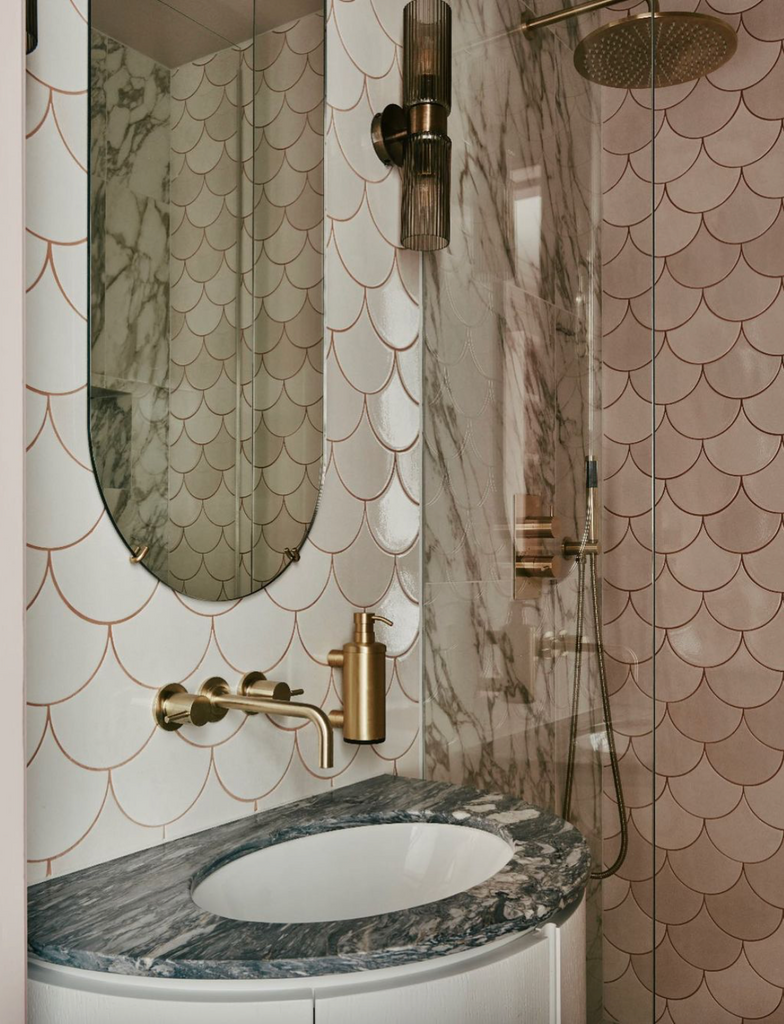Think of scallop tiles and visions of tropical locales likely come to mind. One look at the undulating sea green wall at hotspot Hotel San Cristobal in Todos Santos, Mexico says it all. Or perhaps you’re picturing something more modern, like the outdoor shower that could be yours if you rent this photographer’s former villa in Bali. But these shapely tiles, also called fish scale, mermaid, or fan tiles, are turning up in unexpectedly urban locales and ditching the aquatic hues to boot.

In London, two designers found wildly different sources of inspiration. For Base Interior’s Creative Director Deborah Bass, it was a tween girl’s love of Harry Potter that spurred the whimsical tile choice for this en suite in a Marylebone mansion block, left. “It speaks to her personality and is a bit aspirational as well, it will grow with her,” she says of the overall scheme. To balance that playfulness with a sense of sophistication, she chose timeless white fish scale tiles from Grestec—set with pink grout—and juxtaposed them with elevated light fixtures, a calacatta marble accent wall and palissandro bluette marble on the vanity. “Bringing marble in grounds the scallop, so there’s a bit of earthiness, it’s not too clinical,” she says. A tinted glass shower enclosure also adds glamour and depth to the space.
In true English style, designer Amy Stoddart looked not to the sea, but to the garden for inspiration in this Fulham cloakroom, centre. Tucked off a hallway en route to the back garden, she went for a playful homage with House of Hackney’s Hollyhock wallpaper and Farrow & Ball’s Cooking Apple Green on the woodwork, “to bring it to life,” she says. It’s a petite space so a mini splashback was on order. Rather than a wider, more traditional scallop shape, she opted for Balineum’s S16 Scallop (an unadorned version from the Hanley tube lined collection). Its narrow profile, inspired by patterns in John Gillow’s African Textiles book, was ideal for the room’s small footprint. Plus, “the arched detail gave something quite different than a standard subway tile and it also reminded us of the shape of a flower. That relationship [to the wallpaper] is really sweet and soft,” she notes.
Over on the Continent, design firm Habiteum, installed a mosaic of pale pink scallop tiles from Briare in a child’s bathroom in Paris, right. As with Bass and Stoddart, they complimented the rosy hue with brushed brass fittings for added warmth. Follow Habiteum’s lead and install scallop tiles in an ascending pattern or do as Bass did and install them facing downwards. You can cut them straight at the top for a clean finish or leave the top rounded as Stoddart did for a more organic approach. With the wider profile tiles, you can also try facing them towards each other for even more visual movement, as designer Andy Beers of Ore Studios did in this Seattle, Washington kitchen.
Finally, consider your colour palette. You can mix and match tile colours within a pattern, as seen at Hotel San Cristobal; use one hue as a border against another, as designer Jae W V Kim did in this London family bathroom; or design your own colour scheme, as Waldo Works did, layering shades of blue and yellow glazes in their design of our S16. Should you be interested in doing the same, do get in touch.
PS - Speaking of tropical references, an exhibit just opened at the Victoria & Albert Museum that traces the evolution of 1920s European Modernism in West Africa and India following their freedom from colonialism. Titled Tropical Modernism: Architecture and Independence, it's well worth a visit.
Photos: Christopher Horwood, courtesy Base Interior; Chris Snook, courtesy Amy Stoddart; Julien Pépy, courtesy Habiteum

